The Counterfeit That’s Not A Counterfeit… Or Is It?
(The 1611 “Peso De Minas”)
by Daniel Frank Sedwick
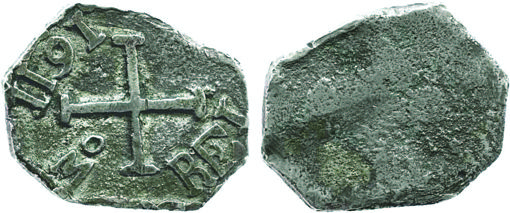
Mexico “peso de minas” 1611 (34.5 grams), Sedwick Auction #9 (April 2011), lot #1634,sold for $325 + buyer’s fee (18%)
For over a century and a half now, numismatists have known about the existence of strange, thick, cast-silver pieces with sharply cut edges that defy both attribution and custom, as they are unlike any other known issues in terms of design and weight: the 1611 “peso de minas” of MexicoThe typical “8 reales” specimen weighs around 35-38 grams and measures about 35 x 28 x 5 mm.. Most Mexican specialists have run across these pieces at some point and, like me, treated them with doubt but stopped short of outright condemnation. Recently I decided to try to get to the bottom of it and discovered that these pieces have been around for longer than I thought—and were not always considered spurious. This article presents the full published history I could find on this “1611 peso de minas” issue, along with some modern metallurgical analysis leading to some tentative conclusions.
Published Reference History
| Reference and year | Comment on authenticity |
| 1854 Orozco y Berra (Diccionario Universal… Tomo V) |
“un peso de plata de los que servían en las minas para las contrataciones” “a weight of silver of those who served in the mines for trade” |
| 1866 Campaner y Fuertes (Memorial numismático español) |
“sumamente extraño, cuya significación no conocemos” “very strange, whose significance we do not know” |
| 1892 Vidal Quadras y Ramón | No comment on authenticity. |
| 1908 Ulex Collection (Adolph Hess) | No comment on authenticity. |
| 1914 Herrera (El Duro) | No comment on authenticity. |
| 1919 Medina (Monedas Obsidionales) | Quotes Orozco y Berra and Campaner y Fuertes |
| 1929 Guttag Collection (Adams) | “This piece is in a number of collections, but no one seems to know its origin.” |
| 1938 Pradeau (Numismatic History of Mexico) | Photo plate says: “Doubtful and Bogus pieces.” |
| 1950 Dasí (Estudio de los Reales de a Ocho) | Quotes Pradeau, no comment on authenticity. |
| 1958 Burzio (Diccionario de la Moneda Española) | Quotes Medina, no comment on authenticity. |
| 1965 Yriarte (Catálogo de los Reales de a Ocho…) | No comment on authenticity… value “$120”. |
| 1970 Calbetó (Compendium VIII Reales) | “Peso de minas. ¿Falsa?” = “Mine weight. Fake?” |
| 1981 Grove (Coins of Mexico) | “made to defraud collectors” |
| 2005 Cayón (Las Monedas Españolas…) | “Peso de minas.” = “Mine weight.” |
| 2008 Calicó (Numismática Española) | “Peso de Minas. Existen falsificaciones.“ = “Mine weight. Fakes exist.” |
The above table shows the fifteen references known to me, illustrating several key points:
(1) The piece was not known to numismatists until 1854.
(2) Doubts about its authenticity started as early as 1866 (“sumamente extraño”).
(3) Strong condemnation came in 1938 and 1981, but just as many references remained neutral.
Serious numismatists will recognize that these references are all revered and respected and are not just sales brochures or amateur articles. In fact, I am not including here several auction-catalog references for the many times these pieces have come up for sale over the past 150+ years. It is worth noting that the “1611 peso de minas” issue has appeared in many important collections and still does today.
Note that the most recent reference in the above table, Calicó, is the only one to propose the possibility that there are legitimate pieces but also fakes thereof. As we shall see, this may be the best explanation.
Now we shall examine some of the above references in depth, one by one, to grasp the evolution of the legitimacy of the “1611 peso de minas” issue.
1854 Orozco y Berra (Diccionario Universal de Historia y de Geografía, Tomo V)
This massive ethnological work, published in Mexico City, featured articles by the leading Mexican scientists and experts of the time, covering such diverse topics as native religion, military battles, important family genealogies, geography and (most germane to our field) commerce. A foldout plate of coin rubbings shows various Mexican coinage, and our “1611 peso de minas” issue appears on the second row from top, third from left.
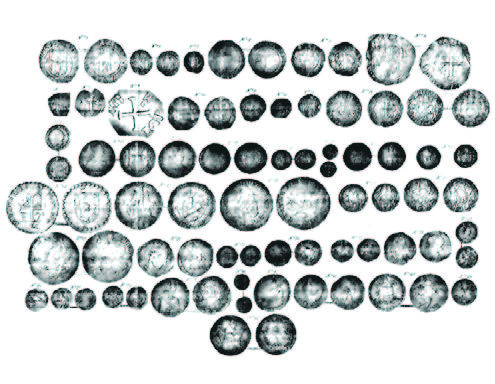
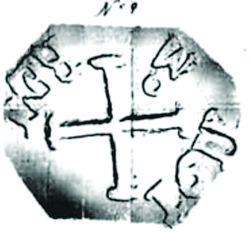
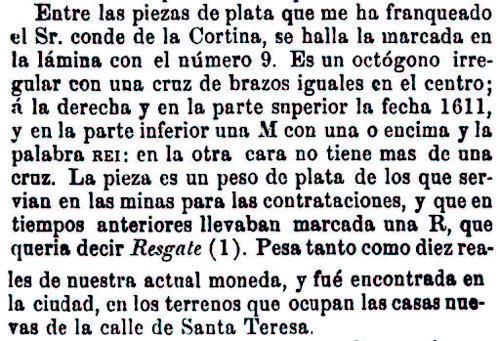
The associated text can be translated as follows:
Among the pieces of silver that the Count de la Cortina has handed me is the one marked on the plate with the number 9. It is an irregular octagon with a cross with equal arms in the center; to the right and in the upper part the date 1611, and in the lower part an M with one or above and the word REI; on the other side it has no more than a cross. The piece is a silver weight of those who served in the mines for trade [or hiring?], and who in previous times had marked an R, which meant resgate On other pages this same work describes the nature and purpose of resgate, a term that does not translate well into English. Suffice to say it was a form of currency within the mine.. It weighs as much as ten reales of our current currency, and was found in the city, on the land occupied by the new houses of Santa Teresa Street.
The background information presented here is frustratingly sparse, of course, but there is an air of legitimacy that made subsequent numismatic collectors feel the need to locate this piece and add it to their collections. Unfortunately there is also enough information here to allow a crook to create a replica, particularly in the face of collector demand: the design, weight, size and shape are all there to see. But there is one key omission: the reverse is not shown and is simply described as “no more than a cross.”
1919 Medina Monedas Obsidionales
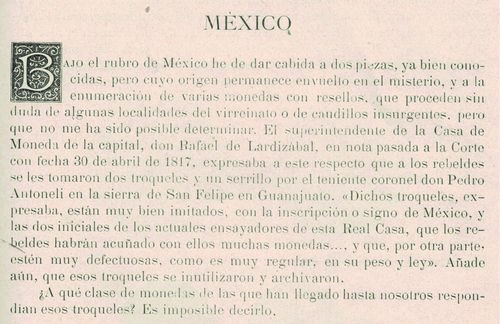
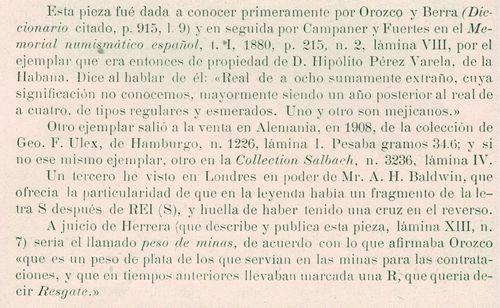
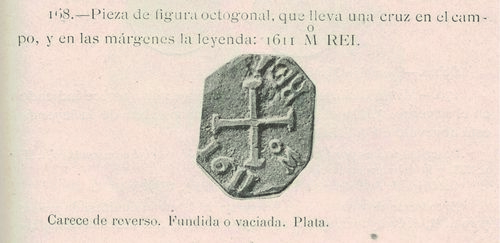 Passing several decades of appearances of the “1611 peso de minas,” which generally mimic or refer to the 1854 work, next we focus on J. T. Medina’s 1919 landmark opus on odd currency, Monedas obsidionales. Medina’s works are still used today and are known for their scholarly integrity. For this piece he shows only an obverse photo and calls it “Pieza de figura octogonal, que lleva una cruz en el campo y en las márgenes la leyenda: 1611 oM REI” (“octagonal piece that carries a cross in the field and in the margins the legend 1611 oM REI”). Medina also states: “Carece de reverso. Fundida o vaciada. Plata.” (“Lacking reverse. Cast or poured. Silver.”). In the span of 65 years, this piece seems to have lost its reverse design, most likely because the reverse was not shown in the 1854 reference. I believe this is a significant clue.
Passing several decades of appearances of the “1611 peso de minas,” which generally mimic or refer to the 1854 work, next we focus on J. T. Medina’s 1919 landmark opus on odd currency, Monedas obsidionales. Medina’s works are still used today and are known for their scholarly integrity. For this piece he shows only an obverse photo and calls it “Pieza de figura octogonal, que lleva una cruz en el campo y en las márgenes la leyenda: 1611 oM REI” (“octagonal piece that carries a cross in the field and in the margins the legend 1611 oM REI”). Medina also states: “Carece de reverso. Fundida o vaciada. Plata.” (“Lacking reverse. Cast or poured. Silver.”). In the span of 65 years, this piece seems to have lost its reverse design, most likely because the reverse was not shown in the 1854 reference. I believe this is a significant clue.
Note also that Medina gives what we have to believe is a complete numismatic history of this piece, starting with Orozcoy Berra (1854) and Campaner y Fuertes (1866)Medina cites an 1880 edition of Campaner y Fuertes, but the original appears to be 1866.. He continues to cite specimens in the collections of Ulex, Salbach and A. H. Baldwin (yet not Vidal Quadras y Ramón, curiously, which did have a specimen), the last-mentioned with notation as having a fragment of the letter S after REI (hence “REIS”) and the reverse design originally described by Orozco y Berra: “no more than a cross.” This Baldwin specimen is unpublished and its whereabouts are unknown, which is a shame because it is the only one cited since 1854 to have designs on both sides. Medina also mentions a citation in the Herrera reference of 1914 for completeness.
1929 Guttag Collection
Ten years later, in 1929, the “1611 peso de minas” issue appeared in the major collection of Julius Guttag of New York City, the catalogCatalogue of the Collection of Julius Guttag New York N. Y. U. S. A. concerning the Coinage of Mexico, Central America, South America and the West Indies, Arranged by Edgar H. Adams, New York, 1929 for which (by Edgar Adams) calls it an “Eight Reales” and mentions a smaller (“four reales”) version in the collection of the American Numismatic Society (ANS).
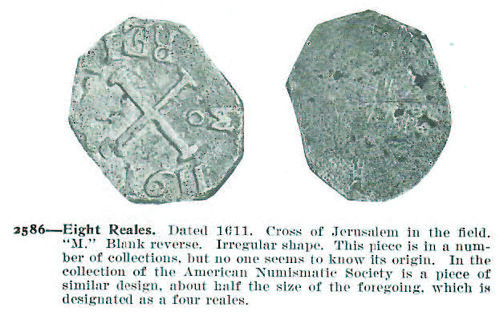 Curiously, while all the earlier, Spanish-language references vacillate about the nature of the piece, the Guttag catalog voices stronger doubt, saying “no one seems to know its origin.” The Guttag specimen shows a blank reverse, as described by Medina and in contrast to the one mentioned by Orozco y Berra and the one attributed to A. H. Baldwin.
Curiously, while all the earlier, Spanish-language references vacillate about the nature of the piece, the Guttag catalog voices stronger doubt, saying “no one seems to know its origin.” The Guttag specimen shows a blank reverse, as described by Medina and in contrast to the one mentioned by Orozco y Berra and the one attributed to A. H. Baldwin.
1938 Pradeau Numismatic History of Mexico
Even greater skepticism about the “1611 peso de minas” issue is manifest in Pradeau’s august work on Mexican coinage, where he shows two examples (presumably the original “8 reales” to the right as well as the ANS-owned “4 reales” on the left) on a photo plate entitled “Doubtful and Bogus pieces”.
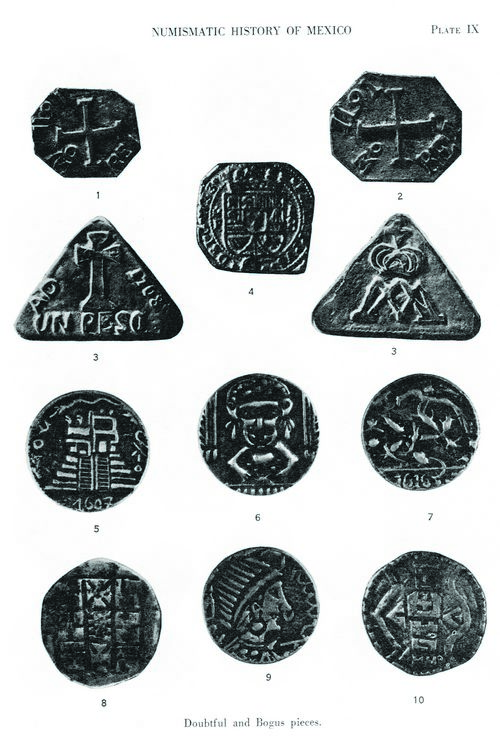
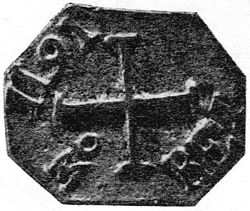
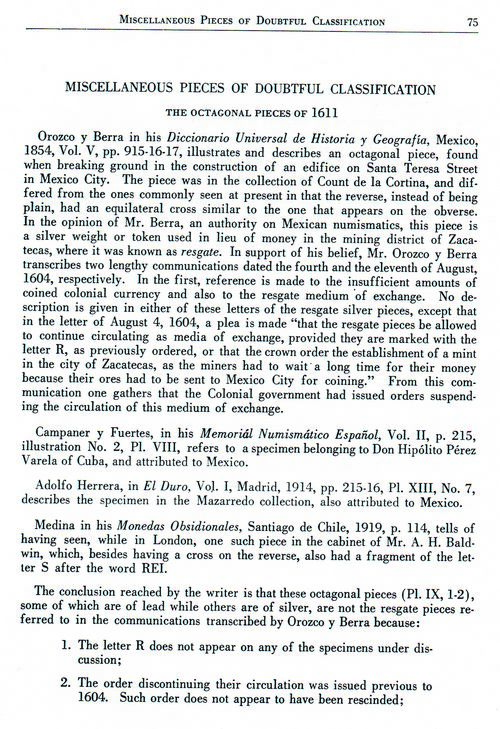

His accompanying text, which regurgitates the same history that Medina found in Orozco y Berra, Campaner y Fuertes and Herrera, summarizes that:
these octagonal pieces…, some of which are lead while others are of silver, are not the resgate pieces referred to in the communications transcribed by Orozco y Berra because… the letter R does not appear on any of the specimens…, the order discontinuing their circulation was issued previous to 1604… pieces bearing any other date, either before or after 1611 are not found… [and] the presence of oM, the mark of the Mexico City mint, does not necessarily mean that such pieces were minted in the city of Mexico, first, because the pieces are cast; secondly, because if the government declared the illegality of such media, one naturally assumes that they were not issued by any branch of it.
While all good points, nothing mentioned by Pradeau would definitely preclude the manufacture of a private issue within the mines for use only there, nor does he consider the possibility that “1611” was not a date but just a number of some other significance. He was not the harshest critic, as we shall see, but apparently his opinion was not carrying full weight outside of Mexico.
1958 Burzio Diccionario de la moneda Española
Within twenty years of Pradeau, Burzio’s DictionaryHumberto F. Burzio, Diccionario de la Moneda Hispanoamericana, II, Letras M a Z, Fondo Histórico y Bibliográfico José Toribio Medina, Santiago de Chile, 1958 continued to consider the “1611 peso de minas” issue as legitimate, or at least worth cataloging as something other than “doubtful.” His entry shows both the “8 reales” version (supposedly still the weight of 10 reales) and the “4 reales” version (inferred by photo sizes, as weights are not given), yet tantalizingly he does not show the reverses, just describes them as “liso” (smooth).
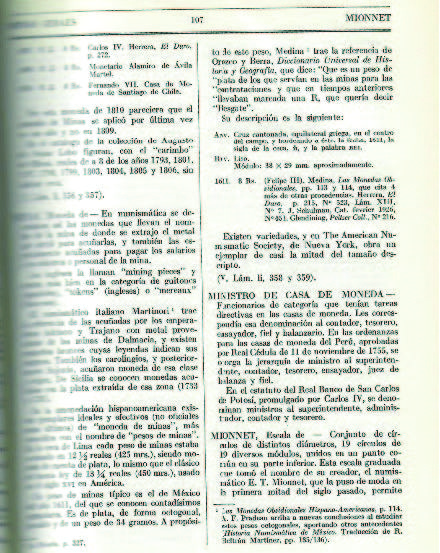

In addition to the specimens cited by Medina, Burzio mentions others sold at auction in the 1920s by Schulman and Glendining. He also describes the ANS specimen as being “de casi la mitad del tamaño descripto” (“of almost half the size described”).
1981 Grove Coins of Mexico
Finally we come to Grove, the most outspoken critic of this issue in his 1981 work, Coins of Mexico. In his list of dates known in 8 reales, there is an asterisked line that states unequivocally, “The 1611 uniface bar-tipped cross, REI was made to defraud collectors.”
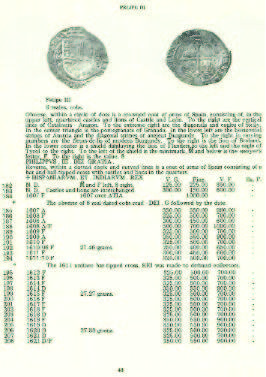
Grove’s terse and brusque assessment offers no explanation, nor does it take into account the pieces stated by Orozco y Berra originally as having “no more than a cross” on the reverse (as opposed to being uniface).
Did Grove know about the non-uniface pieces, or about the “4 reales” piece at the ANS? Is he condemning the whole issue or just the type he specifically mentions? We will never know.
The American Numismatic Society Specimens (yes, they have both!)
Through correspondence with Gilles Bransbourg, Deputy Director of the American Numismatic Society, I ascertained that the ANS collection not only has the “4 reales” previously mentioned but also one of the many known “8 reales,” both acquired in 1917. The “4 reales” weighs 18.014 grams and the “8 reales” weighs 37.930 grams. From the following photos we can see that both are uniface and appear to be castMany thanks to Gilles Bransbourg for his assistance..
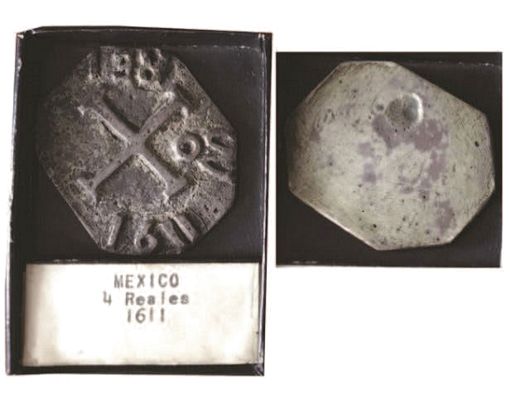

(Credit: American Numismatic Society, accession numbers 1917.118.2 / 92616 and 1917.91.2 / 92615)
XRF Analysis
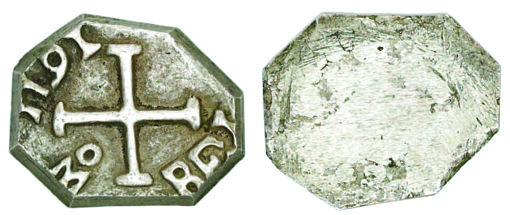
I have a specimen of my own, a uniface piece with weight roughly corresponding to 10 reales (35.05 grams), and recently I was able to analyze it using an XRF (X-ray fluorescence) “gun” Many thanks to Max Keech and World Numismatics LLC for this service.. Typically, different parts of the surface showed different compositions, and the device is unable to penetrate the surface far enough to determine whether the metal is the same within. Also, knowing what metals are on the surface of a subject piece does not preclude the possibility that “old” metal was reused. Nevertheless, XRF technology is good for detecting trace elements that should or should not be in metals of a certain age. In the case of my specimen, I obtained the following readings using different calibrations and locations on the surface:
(1) 82.59% silver, 15.41% copper, 1.70% gold, 0.16% zinc, 0.14% platinum
(2) 88.35% silver, 10.57% copper, 1.07% gold
(3) 91.00% silver, 8.25% copper, 0.69% gold, 0.05% nickel
(4) 88.74% silver, 10.29% copper, 0.96% gold
(5) 87.12% silver, 11.33% copper, 1.06% gold, 0.22% iron, 0.09% nickel, 0.08% tungsten, 0.07% zinc, 0.03% selenium
(6) 85.64% silver, 11.18% copper, 1.28% tin, 1.17% gold, 0.41% iron, 0.17% tungsten, 0.15% zinc.
The average percentages for the top three elements are 87.24% silver, 11.17% copper and 1.11% gold, with an average of just 0.48% in various trace elements. This is not a typical composition for silver coins (modern or old) Actually it is close to an obscure standard known as “84 zolotnik Russian silver,” but it seems unlikely that any quantity of Russian silver would have been sourced to make these pieces., and all of the trace elements could be naturally occurring, so it seems unlikely that this piece, and perhaps any of the “1611 peso de minas” issues, is a modern concoction using either new silver (which would have different trace elements) or old silver (from colonial-era coins, for example). A crudely refined, localized ore at the mine actually makes the most sense.
Summary and Conclusions
While there is ample evidence that the mines used a form of “in house” currency known as resgate, the fact that these “1611 peso de minas” pieces did not surface until 1854 is suspicious, and that suspicion is voiced as soon as twelve years later. The 1854 reference described a two-sided piece but showed only the obverse, and it did not mention a smaller version. The full-size, two-sided piece was re-discovered in the Baldwin cabinet in the early 1900s, and the half-size piece, albeit uniface, turned up in the ANS collection around the same time. Except for truly modern copies (not covered here), there seems to be consistency in weight and details among the known examples, and no two are exactly alike in terms of their surfaces and cut sides. There are three possible conclusions we can make from this data:
(1) These are all fantasies, starting with a specimen in the 1850s whose inclusion in a well-respected publication created demand among top collectors, spawning more castings (basically “fakes of fakes”).
(2) These are all legitimate pieces, some uniface and some two-sided, just perhaps not created in 1611 but later.
(3) There were some original pieces with design on both sides, but demand from the 1854 publication spawned castings for collectors using only the side that was pictured, in line with the opinion of Calicó in 2008.
My personal preference is number three, but unfortunately we cannot know the truth unless more documentation is found prior to 1854. Like all the collectors since 1854 we will continue to collect and trade in these pieces in the meantime.
